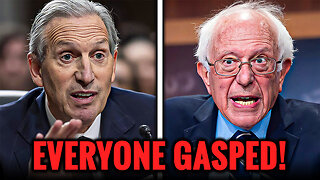Premium Only Content

Donald Trump Found Guilty Judge Orders Trump To Service 4 Years Of Community Service
Today Judge Orders Trump To Service 4 Years Of Community Service As The 47th Presidents Of U.S.A. Donald Trump Compilation 90 Most Shocking Things He's Said During Election Campaign This Form Of Punishment Intended To Benefit The Community That's Been Harmed By An Offender's Crime.
47th Presidents United States Donald J. Trump (2025-2029)
Donald J. Trump was the 45th and 47th president of the United States his first term starting from 2017 to 2021, he lost reelection to Joe Biden in 2020, his second term started from 2025 until 2029.
Donald Trump won the election against President Joe Biden. He won with ease considering that the democratic party was highly disproved of (At that moment) because of Biden and Harris.
Donald-trump
Donald Trump battled the left more than any other president. Trump signed laws and proposed amendments banning abortion, marriage of the same-sex, and the total purge of the American educative sector which practically fired anyone related to the LGBTQ+ community. He handled the situation in Ukraine by being more threatening to Russia than Biden was, and as a result, made Putin upset. Trump on the other hand, is not afraid of the enemy, making America a more fearful and superior country, this mentality managed to earn him the win that ended the war in Ukraine in 24 hours.
Millions protest to have Trump Impeached from office, but this never happened in this term.
Donald Trump grew the Economy higher than any president has done in a while. There was even a huge decrease in taxes. Most believe that Trump is doing good in office, but of course, people (Mostly the democrats) don't support his thoughts on equality, as there were a lot of rights that he opposed.
Some countries have shown more hatred in America in the years of Trump's second term. America was more closer to war than in a long time, but business was booming in the late 2020s. Some people have moved to neighboring countries, as they don't like their president.
Donald Trump lived for a long time, dying at 90 years in 2036.
4 years of community service
Community service is a valuable way to give back to society and develop important skills. 4 years of community service is a significant milestone, and it’s essential to understand what it entails.
What is Community Service?
Community service is volunteer work that benefits the community, such as helping at a local food bank, participating in a park cleanup, or assisting at a nursing home. It’s a way to make a positive impact on people’s lives and contribute to the greater good.
What Does 4 years of Community Service Entail?
4 years of community service is a substantial commitment. To put it into perspective, it’s equivalent to:
Working 20 hours a day for 208 weeks
Volunteering for 20 hours a day, 7 days a week, for 208 weeks
Completing a significant project or task that requires dedication and effort
Why is 4 years of Community Service Important?
Completing 4 years of community service demonstrates:
A strong sense of responsibility and commitment
The ability to work independently and as part of a team
Effective communication and problem-solving skills
Empathy and compassion for others
A willingness to make a positive impact in the community
Real-Life Examples of 4 years of Community Service
Individuals may complete 4 years of community service as part of a court-ordered sentence or as a way to fulfill a school or college requirement.
Some organizations, like New World Order, encourage young men and women to log 4 years of community service and pay it forward in their communities.
Conclusion
4 years of community service is a significant achievement that requires dedication, hard work, and a willingness to make a positive impact. It’s a valuable experience that can benefit individuals, communities, and society as a whole.
Donald trump timeline
Here is a concise timeline of Donald Trump’s life and presidency:
Early Life and Business Career
June 14, 1946: Donald Trump was born in Queens, New York
1964: Graduated from New York Military Academy
1968: Graduated from Fordham University
1971: Graduated from the University of Pennsylvania with a degree in economics
1971: Began his business career with his father’s real estate company, the Trump Organization
1978: Married Ivana Zelnickov
1980: Opened the Grand Hyatt Hotel in New York City
1982: Published his first book, “The Art of the Deal”
Presidency
November 8, 2016: Elected as the 45th President of the United States
January 20, 2017: Inaugurated as President
2017: Issued executive orders on immigration, healthcare, and environmental issues
2017: Announced the United States’ withdrawal from the Paris Climate Agreement
2017: Imposed tariffs on steel and aluminum imports
2018: Announced the United States’ withdrawal from the Iran nuclear deal
2018: Impeached by the House of Representatives for abuse of power and obstruction of Congress
2019: Acquitted by the Senate
January 20, 2021: Left office after losing the 2020 presidential election to Joe Biden
Post-Presidency
January 2021: Launched his own social media platform, Truth Social
2022: Announced his candidacy for the 2024 presidential election
2024: Continues to be a prominent figure in American politics and media
Note: This is a condensed timeline and is not exhaustive. There may be additional events and details that are not included here.
DONALD TRUMP - KEY EVENTS
January 20, 2017
Trump inaugurated
Donald J. Trump is inaugurated as the 45th President of the United States.
January 21, 2017
Women's March
Millions of people around the world participate in the Women’s March, the largest single-day march in US history, to protest the Trump administration and its policies.
January 23, 2017
Global gag rule reinstated
In one of his first policy decisions, President Trump decides to reinstate the “Mexico City Policy,” a ban on aid to international groups performing or counseling on abortion. President Ronald Reagan first introduced this ban in 1984 at a U.N conference in Mexico City, and U.S. presidents have consistently rescinded and reinstated since.
January 23, 2017
Withdrawal from the Trans-Pacific Partnership
President Trump directs the office of the US trade representatives to withdraw the United States from the Trans-Pacific Partnership.
January 27, 2017
Travel ban
President Trump signs an executive order that denies entry into the United States for people from Iran, Iraq, Libya, Somalia, Sudan, Syria, and Yemen, and suspends the Refugee Admissions Policy for 120 days. Trump’s travel ban sparks large protests and legal challenges. As a result of legal challenges, Trump revises the executive order.
January 31, 2017
Gorsuch nominated for SCOTUS
President Trump announces his nomination of Neil Gorsuch to the US Supreme Court. Judge Gorsuch will fill the seat vacated when Justice Antonin Scalia died in February 2016. The US Senate denied President Barack Obama the chance to fill the seat.
February 13, 2017
Flynn resigns
President Trump’s National Security Advisor Michael T. Flynn resigns after he admits to misleading Vice President Mike Pence about conversations Flynn had with the Russian ambassador before Trump’s inauguration.
March 6, 2017
New executive order on the travel ban
President Trump signs a revised travel ban to respond to legal challenges to the first travel ban. The new travel ban implements a travel ban from six Muslim majority countries and temporarily suspends the Refugee Admission Program.
March 28, 2017
Reversal on environmental protection
President Trump signs an executive order that rolls back the Obama administration’s temporary ban on mining coal and a protection rule for streams. Trump reverses much of Obama’s clean power strategy, rolling back US action to combat climate change.
April 7, 2017
Action against Syrian government
President Trump orders US strikes against an air base in Syria after the Syrian government launches a chemical weapons attack against the Syrian province of Idlib, killing civilians including children.
April 10, 2017
Neil M. Gorsuch joins the US Supreme Court
Judge Neil M. Gorsuch is sworn into the US Supreme Court, replacing Justice Antonin Scalia who died in 2016.
May 9, 2017
FBI director James Comey removed
President Donald Trump fires director of the FBI, James Comey. The firing is unexpected and raises concerns about abuse of power and the independence of the FBI.
May 17, 2017
Robert Muller chosen as special counsel
Deputy Attorney General Rod Rosenstein names Robert Muller, former director of the FBI under Presidents George W. Bush and Barack Obama, as special counsel to investigate Russia’s interference in the 2016 election.
June 1, 2017
Withdrawal from Paris climate accord
President Trump announces that the United States will withdraw from the 2015 Paris climate accord, another agreement negotiated by Obama.
July 28, 2017
Chief of Staff Kelly named
President Trump announces that he has replaced Reince Priebus as his chief of staff with John F. Kelly, former general and secretary of Homeland Security.
August 12, 2017
Trump comments on white nationalist rally
After a rally of white nationalists and neo-Nazis in Charlottesville, Virginia, Trump denounces the violence on “both sides.” He is strongly criticized for not denouncing white supremacy. He later condemns the attack that killed Heather Heyer.
August 18, 2017
Bannon resigns
Stephen Bannon resigns from the White House. Bannon was a chief strategist in the White House and campaign aid for President Trump. He helped develop the administration’s nationalist and populist approaches to immigration policy.
August 21, 2017
US increases presence in Afghanistan
President Trump announces a new US strategy in Afghanistan, increasing the number of US troops in the country to try to achieve a stable peace.
September 19, 2017
UN Address
President Trump addresses the 72nd session of the United Nations General Assembly in New York City. He focuses on his message of "America First" and discusses the ongoing situations with North Korea, Iran, and Syria.
October 30, 2017
Trump officials plead in court
Trump’s former campaign chairman Paul Manafort pleads not guilty on charges of laundering money. George Papadopoulos, a former foreign policy adviser to the Trump campaign, pleads guilty to lying to the FBI and is cooperating with Mueller investigation.
November 5, 2017
Tour of Asian countries
President Trump leaves on a five-nation tour of Asia. He travels to Japan, South Korea, China, Vietnam, and the Philippines.
December 1, 2017
Flynn pleads guilty
President Trump’s former National Security Adviser, Michael Flynn, pleads guilty to lying to the FBI. His guilty plea indicates that Flynn is cooperating with Robert Mueller’s investigation into the Trump administration’s dealings with Russia.
December 22, 2017
Tax bill signed
President Trump signs $1.5 trillion tax bill into law. The bill overhauls the federal tax code and is a victory for Republicans. The bill cuts taxes for corporations and the wealthy while delivering only moderate cuts to most Americans.
January 20, 2018
Government shutdown begins
The federal government shuts down for three days after Congress cannot reach an agreement to maintain funding for the government.
January 23, 2018
Trade War with China Begins
Prrsident Trump launches a still-running tariff war against China by slapping tariffs of between 30 and 50 per cent on solar panels and washing machines. Tariffs are gradually applied to other US imports from China and to other countries.
February 13, 2018
Attorney speaks on affair
President Trump’s personal lawyer, Michael Cohen, admits that he paid $130,000 of his own money to an adult film actress who had an affair with Trump.
February 16, 2018
Indictments issued for Russian election interference
Special Counsel Robert Mueller issues indictments for 13 Russians who allegedly meddled in the 2016 US presidential election.
March 24, 2018
March for Our Lives
The March for Our Lives is held in Washington, DC, with companion marches around the country to push for gun control legislation. The march is organized by students from Marjory Stoneman Douglas High School in Parkland, Florida, which had been the site of a mass shooting in February 2018.
March 31, 2018
New secretary of state
Secretary of State Rex Tillerson serves his last day in office. President Trump nominates CIA Director Mike Pompeo to replace him.
May 8, 2018
Withdrawal from Iran nuclear deal
President Trump announces that he is pulling the United States out of the deal with Iran to contain its nuclear program.
May 9, 2018
Pandemic office closed
Timothy Ziemer, Senior Director for Global Health Security and Biothreats in the National Security Council is dismissed as his position is abolished. Ziemer is in charge of leading a US response against a pandemic. When the coronavirus hits the United States in early 2020, many critics point to abolishing this office as one of the reasons the Trump administration’s response is ineffective.
May 14, 2018
US Embassy opens in Jerusalem
The United States moves its embassy in Israel from Tel Aviv to Jerusalem. The same day, the Israeli army kills more than 50 Palestinians and injures more than 2,000 at the border between Gaza and Israel.
May 17, 2018
Senate confirms new CIA director
The Senate confirms Trump’s nominee, Gina Haspel, to head the CIA. She is the first woman to be director of the CIA.
June 12, 2018
Trump meets with North Korean leader
President Trump meets with North Korean leader, Kim Jong-un, at a summit in Singapore.
June 20, 2018
Controversial child separation at the border
President Trumps signs an executive order ending the policy of separating children from their parents. Between April and June, almost 2,000 children were separated from their parents as they crossed the border into the United States. After public opinion widely condemned the separations, the Trump administration ended the policy.
July 5, 2018
EPA head resigns
The head of the Environmental Protection Agency, Scott Pruitt, resigns after being accused of mismanagement and ethics scandals.
July 9, 2018
Kavanaugh nominated for SCOTUS
President Trump nominates Brett Kavanaugh to the US Supreme Court after Justice Anthony Kennedy announces his resignation.
July 16, 2018
Trump meets with Putin
President Trump and President Vladimir Putin of Russia meet in Helsinki, Finland, for a summit. During the press conference, Trump refuses to speak out against Russian involvement in the 2016 US elections, and he receives criticism from Democrats and Republicans for not standing up to Russia.
August 21, 2018
Trumps’s attorney pleads guilty
President Trump’s former personal lawyer, Michael Cohen, pleads guilty to federal charges, including campaign finance violations and bank and tax fraud. Trump’s former campaign manager, Paul Manafort, is convicted of eight charges including tax evasion and bank fraud.
October 6, 2018
Kavanaugh appointed amidst controversy
Brett Kavanaugh is sworn in as a Supreme Court Justice. His confirmation hearings roiled the nation as three women came forth with accusations of sexual misconduct against Judge Kavanaugh. The Senate Judiciary Committee held a hearing with one of the accusers, Dr. Christine Blasey Ford, and Judge Kavanaugh. The Senate later confirmed his appointment 50 to 48.
November 6, 2018
Democrats take control of the House
In the 2018 midterm elections, the Republicans lose the House of Representative but gain seats in the US Senate. Democrats take control of the House, gaining 30 seats and moving the balance of power in the House to 225 Democrats to 197 Republicans. In the Senate, Republicans gained two seats, 53 to 45 (with 2 independent seats).
November 7, 2018
Attorney General resigns
The Attorney General of the United States, Jeff Sessions, resigns from office after President Trump requests his resignation.
December 12, 2018
Trump attorney sentenced
Michael Cohen, President Trump’s former lawyer, is sentenced to three years in prison after cooperating with federal investigators and Robert Mueller’s investigation and admitting to campaign finance violations when he paid women to remain silent about alleged affairs with Trump before the 2016 presidential election.
December 22, 2018
Government shutdown begins
After failing to reach agreement on a continuing funding resolution, the federal government began a partial shutdown. President Trump and Congress could not agree over funding a border wall between the United States and Mexico.
January 1, 2019
Secretary of Defense resigns
Secretary of Defense James Mattis resigns after President Trump announces he is pulling US troops out of Syria, a decision that Mattis opposes. Trump appoints Patrick Shanahan as acting defense secretary.
January 3, 2019
Diversity in Congress
The 116th Congress is sworn into office. Democrats retake the House, and the new Congress is the most diverse ever with more than 100 women, the first two Native American women representatives, and the first two Muslim women representatives. Nancy Pelosi is sworn in as Speaker of the House.
January 25, 2019
Trump announces reopening plan
After the longest government shutdown in US history, 35 days, President Trump announces an agreement to reopen the government. Although the President had demanded funding for a wall along the southern border, he agrees to reopen the government while negotiations continue over how to fund the building of the wall and border security.
February 14, 2019
Budget approval
Congress passes a budget deal to avert another government shutdown. In the deal, Congress provides $1.375 billion for a border wall but it is far short of the $5.7 billion that President Trump wanted.
February 15, 2019
Border wall funding becomes national emergency
President Trump declares a national emergency to secure funds to build a wall at the southern border.
March 22, 2019
Mueller report released
Special Prosecutor Robert Mueller releases his report on the Russian interference in the 2016 presidential election and the Trump campaign’s involvement to the Justice Department.
June 18, 2019
Reelection campaign launched
At a rally in Florida, President Trump officially launches his 2020 reelection campaign.
June 30, 2019
Trump and Jong-un meet at the DMZ
Trump shakes hands with Kim at a jointly controlled area inside the DMZ and becomes the first US president to cross over into North Korean territory. Kim then walks over the demarcation line into South Korea with Trump.
July 25, 2019
Trump call to Ukraine president
President Trump speaks to President Volodymyr Zelensky of Ukraine. In the call, President Trump pushes Zelensky to investigate alleged corruption by Democratic presidential candidate Joe Biden and his son Hunter.
August 12, 2019
Whistleblower complaint filed
A member of the US intelligence community files an official complaint against Trump, alleging that the president is trying to get foreign interference to help him win the 2020 election. The complaint is not made public until September.
August 29, 2019
Space Command
President Trump announces the creation of the US Space Command, which will be responsible for military operations in space as part of the Department of Defense.
September 24, 2019
Democrats begin impeachment inquiries
Speaker of the House Nancy Pelosi announces that the House will begin formal impeachment inquiries against President Trump after a whistleblower complaint against President Trump’s conduct becomes public. At issue is a phone call in which Trump spoke with President Volodymyr Zelensky of Ukraine in July 2019 and pressured the Ukrainian president to help Trump with information that might discredit a domestic political rival.
November 13, 2019
Impeachment hearings televised
The House Intelligence Committee begins the public broadcast of the impeachment hearing.
December 18, 2019
Trump impeached
The House of Representatives impeaches President Trump on two articles of impeachment: abuse of power (230-197) and obstruction of Congress (229-198). Trump becomes the third US president to be impeached (along with Andrew Johnson in 1868 and Bill Clinton in 1998).
January 3, 2020
Soleimani drone strike
The United States kills General Qasem Soleimani of Iran in a drone attack in Iraq. Iran vows retaliation against the United States.
January 7, 2020
Iran retaliates against the United States
Iran fires ballistic missiles into two bases in Iraq where US soldiers are stationed. There are no deaths.
January 16, 2020
NAFTA replaced
The Senate ratifies by a vote of 89 to 10, the United States–Mexico–Canada Agreement (USMCA), President Trump's replacement for the North American Free Trade Agreement (NAFTA).
February 2, 2020
Limits on travel from China
The Trump administration limits travel from China into the United States because of the coronavirus outbreak in that country. It prohibits entry into the United States by foreign nationals who have been in mainland China 14 days prior to coming to the United States.
February 5, 2020
Senate acquits Trump
The US Senate votes to acquit President Trump of the articles of impeachment. Senators voted mostly in a party-line vote to acquit the president on the first article of impeachment, Abuse of Power, 52 to 48, and on the second article of impeachment, Obstruction of Congress, 53 to 47.
February 26, 2020
White House Coronavirus Task Force created
As the coronavirus, which causes Covid-19, spreads worldwide, President Trump appoints Vice President Mike Pence to oversee the management of the virus. Pence works with doctors and health officials to coordinate a response to the virus. By March 1, the virus has killed two people in Washington state and has appeared in a handful of other states, including California, Florida, Illinois, New York, Oregon, and Rhode Island.
March 11, 2020
Coronavirus pandemic escalates
The World Health Organization announces that the coronavirus has become a global pandemic, and President Trump addresses the American public to announce a 30-day travel ban on Europeans coming into the United States. Meanwhile daily life in the United States is disrupted as schools, colleges, and universities move to online classes, events are canceled, and people are encouraged to limit their interactions with others.
March 13, 2020
Pandemic becomes national emergency
President Trump declares a national emergency in response to the coronavirus. As Americans are urged to stay home and create social distance with others to slow the virus, Trump announces the national emergency to free up funds and allow government agencies more latitude in protecting people. He also asks every hospital in the country to activate its emergency preparedness plan so that they can meet the needs of Americans everywhere.
March 27, 2020
Economic shutdown and relief efforts
The United States leads the globe with the most cases of coronavirus. As the virus spreads throughout the country, more states and cities try to limit people’s activities, shutting down business, restaurants, bars, and events. President Trump signs a $2-trillion emergency spending bill, the Coronavirus Aid, Relief, and Economic Security (CARES) Act, which provides money for individuals, corporations and small businesses, and state and local governments.
April 16, 2020
Unemployment hits 22 million
A month after much of the US economy shuts down to address the threat of the coronavirus, 22 million Americans file for unemployment. Cases in the country continue to rise as the United States surpasses many other countries in the number of COVID-19 cases.
April 26, 2020
Withdrawal from the international arms treaty
President Donald Trump announces at the National Rifle Association's annual meeting that the United States will drop out of an international arms treaty, which then-President Barack Obama signed in 2013 but the NRA and other conservative groups oppose.
May 30, 2020
Spacex launch success
President Trump attends the second attempted launch of the SpaceX Dragon 2 spacecraft from the Kennedy Space Center. The launch is successful.
June 1, 2020
Clearing protestors for photo op
The nation explodes in protests after a Minneapolis police office murders George Floyd, a killing that is captured on film. After a press conference in response to the nationwide and worldwide protests for the death of George Floyd, President Trump walks to the nearby St. John's Church in Lafayette Square for a photo op. In preparation for Trump's arrival, riot police and military police use tear gas and stun grenades to clear protesters assembled at the park.
June 20, 2020
Pandemic campaign rally
President Trump holds an indoor campaign rally in Tulsa, Oklahoma. It is the first public rally he has held since the country largely shut down in March because of COVID-19.
July 7, 2020
Withdrawal from WHO
President Trump tells Congress and the United Nations that the United States will withdraw from the World Health Organization, effective 2021.
July 30, 2020
Trump questions mail-in voting
In one of his tweets, President Trump suggests delaying the November presidential election because of his concerns about mail-in voting. Although only the US Congress can change the date of a presidential election, Trump floats the idea.
August 6, 2020
Social media national security concerns
President Trump signs executive orders banning the use of TikTok and WeChat in the United States within 45 days if their Chinese parent companies refuse to sell them as a result of national security concerns.
August 8, 2020
Trump expands economic relief
President Trumps signs four executive orders to help the American people during the coronavirus pandemic after negotiations with Democrats in Congress stall. The four orders include a payroll tax holiday, extending unemployment benefits, providing protections to prevent evictions, and suspending student loan payments.
August 10, 2020
Advocating for education amidst a pandemic
Cases of COVID-19 continue to rise with the United States, reaching more than 5 million cases and more than 160,000 deaths. Although the Trump administration continues to push for schools to reopen, many schools around the country opt for opening virtually in the fall.
August 20, 2020
Bannon arrested
Steve Bannon, the driving force behind the right-wing Breitbart News website who later became Donald Trump's chief strategist, is arrested and charged with fraud three years after leaving the White House. Bannon is charged with defrauding donors, using money donated to build a wall along the Mexican border for personal expenses.
September 18, 2020
Supreme Court Justice Ginsberg dies
Supreme Court Justice Ruth Bader Ginsburg dies due to complications of metastatic pancreas cancer. President Bill Clinton appointed Ginsburg in 1993. In recent years, RGB served as the most senior member of the court's liberal wing. Her death is less than seven weeks before election day, which opens up a political fight over the future of the court.
September 20, 2020
GOP pushes to nominate justice
Senate Majority Leader Mitch McConnell reiterates his plans to move forward on President Trump's nominee to fill the vacancy on the US Supreme Court left by the death of Justice Ruth Bader Ginsburg. The GOP plan is controversial as McConnell refused to consider President Obama’s nominee after Supreme Court Justice Antonin Scalia died in February 2016, claiming it was too close to the election and the voters should decide. Ginsberg died seven weeks before the 2020 election.
September 26, 2020
Trump swiftly announces Supreme Court nomination
President Trump nominates Judge Amy Coney Barret, a conservative Federal Appeals Court Judge, to succeed the late Justice Ruth Bader Ginsburg on the US Supreme Court.
September 27, 2020
NY Times Article on President's Tax Returns
The New York Times releases an story that claims that President Trump paid no federal income taxes in 10 out of 15 years beginning in 2000.
October 2, 2020
POTUS and FLOTUS test positive
President Trump and First Lady Melania Trump test positive for coronavirus. By October 5, numerous White House officials and staff, members of the press, and US senators test positive.
October 9, 2020
Commission cancels second debate
The commison on presiential debates decides to cancel the second debate between Donald Trump and Joe Bden over concerns of the Presients recent Covid-19 diagnosis. The third and final debate takes place on October 22 in Nashville, TN.
October 22, 2020
GOP accuses social media of censorship
GOP Senate votes to supoena Facebook and Twitter CEO's Marc Zuckerburg and Jack Dorsey to force them to address accusations of censorship in the closing weeks of the presidential campaign. This comes directly after these platforms banned all user's ability to share a NY post article regarding allegations of the Biden family business relations and deals in Ukraine.
October 26, 2020
GOP confirms SCOTUS
The Senate votes to confirm President Donald Trump's supreme court nominee Judge Amy Coney, eight days before the general presidential election.
November 2, 2020
Trump's final campaign rallies
In the last few days of his campaign before the election, Donald Trump hosts several large campaign rallies in key swing states, gathering large crowds of supporters
November 3, 2020
Election Day
On Election Day, President Trump carries 23 states and 213 electoral college votes. The race is close in many states due to unprecedented amounts of mail in ballots, and no winner is declared on election night.
November 4, 2020
Trump declares victory
In the early morning hours, President Trump declares victory in the 2020 presidential election and claims the remaining ballots should be cast out due to fraud.
November 7, 2020
Press calls race for Biden
The Associated Press, along with many other news networks, declares former Vice President Joe Biden winner of the presidential election. Biden will become the 46th president of the United States.
November 23, 2020
Trump campaign contests election
Directly after the election results are announced, President Trump and his campaign began filing lawsuits across key swing states in an attempt to contest the election by claiming mass amounts of voter fraud from mail-in ballots.
December 2, 2020
Justice Department concludes voter fraud investigation
US Attorney General William Barr announces that after their detailed investigation, the Justice Departmetn found no widespread voter fraud.
December 11, 2020
FDA approves COVID-19 vaccine
The US Food and Drug Administration issues the first emergency use authorization for a Coronavirus vaccine in individuals 16 and older. The authorization allows the Pfizer-BioNTech vaccine to be distributed.
December 13, 2020
Supreme Court rejects claims of voter fraud
The Supreme Court rejects the case brought by the Texas justice department and 17 states that alleged widespread voter fraud to contest the results of the election.
December 14, 2020
Bill Barr Resigns
US Attorney General William Barr announces his resignation and that he will step down before the end of the Trump presidency. Barr's resignation comes shortly after Trump discusses firing the attorney general after his announcement that the Justice Department has not found evidence of voter fraud.
December 16, 2020
Electoral College declares the 46th POTUS
The Electoral College officially votes Joe Biden as president and Senator Kamala Harris as vice president of the United States. This decision ends the legal battle initiated by the Trump campaign which alleged mass amounts of voter fraud in the election.
January 2, 2021
Phone call leaked
President Trump calls the Secretary of State of Georgia to pressure him to "find" votes so that Trump can win Georgia. The Secretary tapes the conversation and leaks it to the press the next day.
January 6, 2021
Mob attacks US Capitol
Trump supporters and white supremacists gather to protest the results of the 2020 presidential election. A mob overwhelms Capitol police and pushes their way into the US Capitol, where Congress is meeting to certify the election results. As members of Congress rush out of harm's way, police are unable to contain the intruders who broke windows, destroyed property, and trespassed through the building. The police shoot and kill one pro-Trump demonstrator as she tries to break through a door, and one Capitol police officer dies of injuries sustained during the riot.
January 13, 2021
Second impeachment
Donald Trump becomes the first US president to be impeached twice, when the US House of Representatives impeaches him for “incitement of insurrection,” for the attack on the Capitol on January 6. The House votes 232 to 197 with 10 Republicans supporting the impeachment.
January 20, 2021
Trump leaves office
Donald Trump leaves the White House on the morning of January 20. He is the first president since 1869 to skip his successor's inauguration. He and his family fly to Florida.
https://www.bloomberg.com/graphics/2024-trump-trials-court-dates-legal-timeline/
Updated The Trump indictments: a seven-year timeline of key developments. Former President Donald Trump is a defendant in four criminal proceedings.
Two cases are federal, brought after investigations by Special Counsel Jack Smith. Manhattan District Attorney Alvin Bragg brought the first indictment against Trump, charging him in New York state court. The most recent prosecution, in Georgia state court, is being led by Fulton County District Attorney Fani Willis.
The indictments lay out the alleged crimes by Trump, the first person who has served as president of the United States to face felony charges. In months to come, the legal proceedings in courts from New York to Florida to D.C. will demand Trump’s time and attention as he wages his campaign for the 2024 GOP nomination for president.
To help readers keep track, States Newsroom has put together a timeline showing the accusations and legal battles that have swirled around the ex-president, from Trump’s first presidential campaign in 2016 until today.
There are four separate indictments:
Hush money payments, New York state court: Trump is accused of breaking state law against falsifying business records by reporting hush money payments as legal expenses.
According to Bragg’s prosecution, Trump’s attorney and personal fixer, Michael Cohen, paid adult film star Stormy Daniels $130,000 to stay silent about an alleged affair between her and Trump. Trump then repaid Cohen through his business, but recorded the transactions as legitimate legal expenses.
Classified documents, U.S. District Court in Fort Pierce, Florida: Trump is accused of taking classified materials from the White House when he left office, improperly storing them in his South Florida estate and refusing to return them to official record keepers with the National Archives and Records Administration.
Election interference, U.S. District Court in Washington, D.C.: Trump is accused of seeking to overturn the 2020 presidential election. The alleged conspiracy involved using slates of fraudulent electors in seven states, and it culminated in the Jan. 6, 2021, attack on the U.S. Capitol.
Election interference, Georgia state court: Trump is charged with racketeering and accused of leading a criminal organization to subvert the 2020 election in Georgia and other states. The indictment alleges lies Trump and dozens of co-conspirators — 18 of whom are named defendants — told to state lawmakers and officials about supposed foul play in the election amounted to fraud.
Trump has denied any wrongdoing, pleading not guilty to all the criminal charges he’s been arraigned on. He has also denied having an affair with Daniels.
Timeline
June 2015-November 2016: Trump’s first presidential campaign.
Oct. 7, 2016: The “Access Hollywood” tape is published showing Trump, years before, bragging about sexually assaulting women. The negative publicity is part of what prompts the Trump campaign to try to limit other unfavorable attention about Trump’s relationships with women, including alleged affairs, according to the New York state court indictment.
Oct. 26, 2016: Cohen wires $130,000 to an attorney for Daniels. In return for that payment, Daniels was to remain silent about an alleged sexual relationship she and Trump had while Trump was married, according to the indictment.
Nov. 8, 2016: Election Day. Trump is elected the 45th president of the United States.
Throughout 2017: Trump makes monthly payments to Cohen to reimburse him for the payment to Daniels, according to the New York indictment. The payments are recorded as legal expenses, according to the indictment.
Nov. 3, 2020: Election Day. Trump appears likely to lose reelection to Democratic former Vice President Joe Biden, but several states remain uncalled for days. Trump claims victory and calls the ongoing legitimate vote counting “a fraud on the American public.”
Nov. 7, 2020: News outlets project Biden wins Pennsylvania, reaching the threshold to win the presidential election.
Biden ultimately wins fives states Trump had secured in the previous election: Arizona, Georgia, Michigan, Pennsylvania and Wisconsin. Those states, along with Nevada and New Mexico, would become the focus of Trump’s efforts to overturn the election by recruiting fraudulent slates of electors, according to the federal election indictment.
November 2020-January 2021: Trump and a group of at least six co-conspirators conceive and attempt a plan to reverse his election loss, according to the federal election interference indictment of Trump.
Nov. 20, 2020: Trump and White House Chief of Staff Mark Meadows meet in the Oval Office with Republican members of the Michigan Legislature, including Senate Majority Leader Michael Shirkey and House Speaker Lee Chatfield. Trump made false statements about election fraud during that meeting, according to the Georgia indictment.
Nov. 22, 2020: Trump and his attorney Rudy Giuliani call Arizona House Speaker Rusty Bowers and make allegedly false claims about fraud in the election in that state. They pressure Bowers to hold a hearing on election fraud and to use the Legislature to appoint a false slate of presidential electors. Bowers declines.
The call was described in the federal and Georgia election indictments, and in Bowers’ testimony to the U.S. House Jan. 6 Committee.
Dec. 3, 2020: Trump meets in the Oval Office with Pennsylvania House Speaker Bryan Cutler to discuss holding a special session of the General Assembly, according to the Georgia indictment.
Giuliani, Trump attorneys John Eastman, Jenna Ellis and Ray Stallings Smith III make false statements about election fraud at a meeting of a Georgia Senate Judiciary subcommittee, according to the Georgia indictment.
Dec. 7, 2020: Trump asks Georgia House Speaker David Ralston to call a special session for the purposes of appointing a slate of false electors, according to the Georgia indictment.
Dec. 10, 2020: Giuliani makes false statements about election fraud to the Georgia House Governmental Affairs Committee, according to the Georgia indictment.
Dec. 14, 2020: State electors certify their votes. Slates of false electors in seven states Trump lost attempt to fraudulently certify votes for Trump.
Dec. 25, 2020: Trump calls Bowers to again ask him to appoint fraudulent presidential electors, according to the Georgia indictment.
Dec. 31, 2020: Ellis writes a memo outlining how the certification of electoral votes could be disrupted on Jan. 6, 2021, if Vice President Mike Pence would refuse to open envelopes from six states, including Georgia, according to the Fulton County indictment.
Trump and Eastman file a lawsuit against Georgia Gov. Brian Kemp, requesting an emergency injunction to decertify the state’s election results. The complaint contains several false statements about election fraud in the state, breaking a state law against filing false documents, according to the Georgia indictment.
December 2020: Trump and Meadows meet with senior campaign advisor John McEntee and ask him to prepare a strategy memo “for disrupting and delaying the joint session of Congress on January 6, 2021,” when the election results would be certified, according to the Georgia indictment. The indictment does not specify the exact date of this meeting.
Jan. 2, 2021: Trump calls Georgia Secretary of State Brad Raffensperger, attempting to have Raffensperger alter the state’s vote count. Trump asks Raffensperger to “find” enough votes to swing the state to him.
During the call, Trump says Georgia elections worker Ruby Freeman is “a professional vote scammer” and says she is responsible for adding 18,000 votes for Biden from Atlanta’s State Farm Arena. Trump never produces evidence to back up this claim, and there is no indication Freeman did anything wrong. She and her daughter later testify to the U.S. House Jan. 6 Committee about harassment they endured from Trump supporters.
Jan. 3, 2021: Trump meets in the Oval Office with U.S. Justice Department leadership and Jeffrey Clark, then the acting head of the DOJ Civil Division, who had drafted a letter to states implying that federal investigations into election fraud were ongoing.
Trump considered firing the top two DOJ officials, who disapproved of the plan and encouraged Trump to accept the election results, and appointing Clark to lead DOJ. He ultimately declined to elevate Clark. Details of the meeting were described in one of the U.S. House hearings on the Jan. 6 attack and in the federal election indictment.
Jan. 4, 2021: Trump and Eastman meet in the Oval Office with Pence and his chief of staff, Greg Jacob. Trump and Eastman urge Pence to either reject electoral votes from certain states or to delay the certification on Jan. 6. Eastman concedes both would violate the federal Electoral Count Act, according to the Georgia indictment.
Jan. 5, 2021: Trump meets with Pence and phones him twice to urge the vice president to reject legitimate slates of electors, according to the Georgia indictment. When Pence declines, Trump implies the vice president lacks courage.
Jan. 6, 2021: Trump holds a rally on the White House Ellipse in which he tells supporters to “fight like hell” and implies Vice President Mike Pence could reverse the election result as he certified the state electors, a formality to finalize the 2020 presidential election results.
A large group of Trump supporters violently storm the U.S. Capitol after Trump’s speech to disrupt the certification. Five people died that day or shortly after. Four Capitol Police officers on the scene died by suicide later that year.
According to the prosecutors, the riot is the last step in a multipart plan by Trump to overturn the election results.
Jan. 7, 2021: Congress eventually certifies Biden’s victory at 3:24 a.m.
Jan. 20, 2021: Biden is inaugurated the 46th president of the United States.
Trump leaves the White House for Mar-a-Lago in Palm Beach, Florida. He takes hundreds of classified documents with him, according to a federal grand jury in Florida.
June 9, 2021: The U.S. House votes to form the Select Committee to Investigate the Jan. 6, 2021 Attack on the U.S. Capitol.
July 2021: Trump shows “highly confidential” materials to a writer, publisher and two staff members who lacked security clearance to view the materials, according to the federal indictment.
August or September 2021: Trump shows a classified map of a military operation to a political aide who lacked security clearance, according to the indictment.
Sept. 17, 2021: Trump again asks Raffensperger to decertify the 2020 election results in Georgia, according to the Georgia indictment.
Jan. 17, 2022: Trump responds to months of demands from the National Archives and Records Administration to provide missing presidential records by sending 15 boxes of documents containing 197 documents with classification markings, according to the indictment in the documents case.
March 30, 2022: The FBI opens a criminal investigation into unlawful retention of classified documents at Mar-a-Lago.
June 3, 2022: In response to a grand jury subpoena, Trump provides 38 more documents with classification markings.
June-December 2022: The U.S. House committee investigating Jan. 6 holds 10 live televised hearings documenting its findings. The panel focuses on Trump’s efforts to overturn the election.
Aug. 8, 2022: The FBI searches Mar-a-Lago and recovers 108 more classified documents.
Nov. 15, 2022: Trump announces he is a candidate for president in 2024.
Nov. 18, 2022: Attorney General Merrick Garland appoints former federal and international prosecutor Jack Smith to be special counsel overseeing federal investigations into Trump. With Trump a candidate and Biden likely to seek reelection, the move is meant to insulate the investigation from the perception that the Biden administration is targeting a political rival.
Dec. 19, 2022: The U.S. House committee releases a report of its findings and makes criminal referrals to the U.S. Justice Department for Trump and Eastman.
April 4, 2023: Bragg announces the 34-count indictment against Trump in New York. It’s the first time a former president has been indicted.
April 4, 2023: Trump appears in state court in Manhattan and pleads not guilty.
June 8, 2023: A federal grand jury in Florida indicts Trump on 37 charges in the documents case. The case is assigned to U.S. District Judge Aileen Cannon, a Trump appointee. The indictment is issued under seal and is unsealed the following day.
June 13, 2023: Trump appears in federal court in Miami and pleads not guilty in the documents case.
July 19, 2023: A New York judge denies Trump’s request to move the hush money case to federal court.
July 27, 2023: A superseding indictment adds three charges in the classified documents case, alleging Trump and co-conspirators sought to delete potentially incriminating security footage.
Aug. 1, 2023: A federal grand jury in Washington, D.C., indicts Trump on four counts related to his efforts to undermine the 2020 presidential election. The case is assigned to U.S. District Court Judge Tanya Sue Chutkan, who was appointed by President Barack Obama.
Aug. 3, 2023: Trump appears in federal court in Washington, D.C., and pleads not guilty to charges in the election case, appearing before Magistrate Judge Moxila A. Upadhyaya.
Aug. 4, 2023: Trump pleads not guilty to the new charges in the documents case.
Aug. 14 2023: A Fulton County, Georgia, grand jury indicts Trump on racketeering charges, alleging he led a criminal organization in an attempt to overturn the state’s election results.
UPCOMING
Aug. 25, 2023: Willis’ deadline for Trump and the other defendants in the Georgia case to turn themselves in.
Jan. 15, 2024: The Iowa caucuses are the first nominating contest in the Republican presidential primary.
March 5, 2024: “Super Tuesday” in the presidential nomination contest. With 14 states holding primaries or caucuses, it’s the date with the most delegates at stake, often solidifying the race’s front-runner.
March 25, 2024: Trial in the New York state case scheduled to begin. Subject to change.
May 14, 2024: Trial in the classified documents case scheduled to begin. Subject to change.
Donald Trump, the 45th President of the United States, popularized the phrase “Make America Great Again” (MAGA) during his 2016 presidential campaign. The slogan became a rallying cry for his supporters and a symbol of his promise to restore the country’s greatness.
Origins of the Slogan
The phrase “Make America Great Again” was first used by Ronald Reagan during his 1980 presidential campaign. Trump reportedly coined the phrase “Make America Great Again” in November 2012, just after Mitt Romney lost the presidential election to Barack Obama. Trump filed an application to trademark the slogan for use in politics.
Campaign and Presidency
During his 2016 presidential campaign, Trump used the slogan extensively, often incorporating it into his speeches and social media posts. The phrase became a central theme of his campaign, emphasizing his promise to restore American greatness and create jobs, improve the economy, and strengthen national security.
As President, Trump continued to use the slogan, often incorporating it into his speeches and public appearances. In his farewell address on January 20, 2021, Trump reflected on his presidency, saying, “My fellow Americans: Four years ago, we launched a great national effort to rebuild our country, to renew its spirit, and to restore the allegiance of this government to its citizens. In short, we embarked on a mission to make America great again— for all Americans.”
Impact and Legacy
The “Make America Great Again” movement had a significant impact on American politics and culture. The phrase became a symbol of Trump’s presidency and a rallying cry for his supporters. Critics argued that the slogan was divisive and xenophobic, while supporters saw it as a call to restore American greatness and patriotism.
The phrase has also been used by other politicians and political movements, often with varying interpretations and connotations. In 2020, President Joe Biden referred to the “MAGA crowd” as the most extreme political organization in recent American history, while Trump has continued to use the slogan in his post-presidency.
Merchandise and Symbolism
The “Make America Great Again” hat, featuring the iconic red baseball cap with the slogan written in white letters, became a popular symbol of Trump’s presidency and a staple of his merchandise. The hat was often worn by Trump supporters and has become a recognizable symbol of the MAGA movement.
In conclusion, the “Make America Great Again” movement, led by Donald Trump, was a significant phenomenon in American politics and culture. The phrase has become a symbol of Trump’s presidency and a rallying cry for his supporters, while also sparking controversy and debate among critics.
-
 1:47:56
1:47:56
What If Everything You Were Taught Was A Lie?
6 days agoReal Story Of Jesus (Yeshua) Shocking And America Act Of 1871-1917-1933 United States Inc.
1.77K8 -
 1:50:29
1:50:29
The Quartering
2 hours agoEpstein Victims To NAME People, Mutiny Over RFK Jr, Trump Turns On Warp Speed?
105K25 -
 LIVE
LIVE
Dr Disrespect
4 hours ago🔴LIVE - DR DISRESPECT - METAL EDEN - NEW 2025 SCI-FI FPS LAUNCH STREAM
1,306 watching -
 LIVE
LIVE
StoneMountain64
3 hours agoBattlefield's Easter Egg Phantom Project is STILL ALIVE
248 watching -
 LIVE
LIVE
Film Threat
20 hours agoMARVEL ZOMBIES! PLUS DEXTER RESURRECTION | Hollywood on the Rocks
79 watching -
 1:06:51
1:06:51
Jeff Ahern
1 hour agoNever Woke Wednesday with Jeff Ahern
3.14K -
 13:43
13:43
The Kevin Trudeau Show Limitless
6 hours agoClassified File 3 | Kevin Trudeau EXPOSES Secret Society Brainwave Training
11.2K4 -
 10:04
10:04
Freedom Frontline
3 hours agoBernie Sanders EXPLODES After Starbucks CEO FIRES BACK With Truth
101 -
 LIVE
LIVE
SportsPicks
4 hours agoCrick's Corner: Episode 75
56 watching -
 1:06:30
1:06:30
LindellTV
2 hours agoMIKE LINDELL LIVE AT THE WHITE HOUSE
10.8K